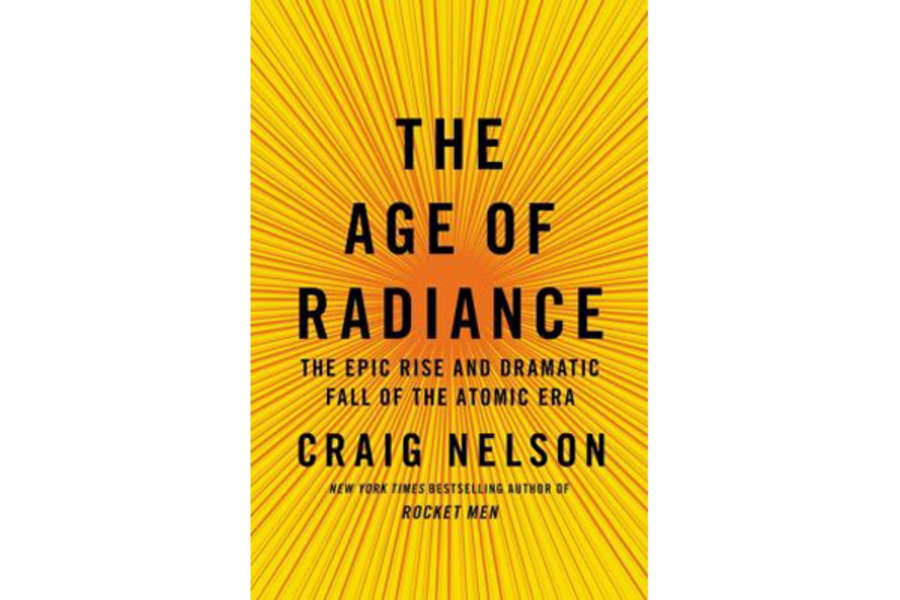The Age of Radiance
Loading...
In the years following World War II, many Americans were so captivated by nuclear weapons that they embraced kitschy household products such as salt and pepper shakers shaped like the two bombs dropped on Japan, as well as comic books about atomic power and a pro-atomic fair in Central Park.
They also embraced the hope that nuclear power would usher in a utopian age of cheap and accessible energy.
Half a century later, after an expensive and terrifying nuclear arms race, several infamous meltdowns of nuclear power plants, and absurd nuclear defense schemes such as the Reagan administration’s “star wars” initiative, public opinion has turned sharply against all things atomic. In the book The Age of Radiance: The Epic Rise and Dramatic Fall of the Atomic Era, author Craig Nelson argues that although we are living in the twilight of the atomic era, it is time for us to educate ourselves about nuclear power, remove the dark and mystical aura that surrounds it, and reap its benefits.
This call to action comes at the end of a thrilling, intense, and disturbing account of the scientific and sociopolitical history of the atomic era, from the discovery of X-rays to the tragic meltdown of Japan’s Fukushima Daiichi nuclear power plant in March 2011.
When Nelson first set out to research this history, he expected to discover a narrative about the dangers and horrors of atomic energy and nuclear weapons. But as he says in his introduction, the story is far more nuanced.
His narrative begins in the late 19th and early 20th centuries with the discovery of X-rays and radium. It progresses through the scientific discoveries of the 1930s and ’40s, chronicling the personalities and biographies of scientists such as Enrico Fermi and Edward Teller, who raced against the clock to create an atomic bomb before the Nazis.
It continues, after World War II, through the division in the scientific community over whether to engage in an arms race or adopt an arms control policy with the Soviets.
The narrative ends with the stories of Three Mile Island, Chernobyl, and the 2011 Fukushima meltdown. Throughout, Nelson addresses infamous events such as the dropping of the atomic bombs on Hiroshima and Nagasaki, as well as lesser-known – and sometimes even comic – historical episodes such as the 1890s X-ray craze that led a London manufacturer to provide shielding undergarments to women so they wouldn’t fall victim to X-ray-equipped voyeurs.
Nelson’s book is rich with powerful images, ranging from Marie Curie admiring her blue and green glowing radium in her darkened laboratory, flush with the scientific optimism of the early 20th century; to scientists watching the first mushroom cloud rise over the New Mexico desert after the testing at Los Alamos; to the natural idyll that has become the land around Chernobyl, a land full of bears, badgers, and cormorants in the absence of humanity.
Nelson’s narrative drags in places, such as the sections in which he describes the squabbles among the different scientific personalities making various discoveries in the 1930s, all of which built up to the first atom bomb. But these slow sections are few and far between, and most of “The Age of Radiance” is fraught with drama – no small feat for the writer of a story to which readers already know the ending.
There is real tension in the portion of his narrative in which scientists race to finish an atomic weapon before the Nazis, bolstered by such film-worthy details as Jewish scientists escaping occupied Europe in the nick of time and a daring mission to bomb a heavy water facility in Nazi-controlled Norway. The sections in which Nelson describes the millions of dollars spent on a futile arms race during the cold war are full of drama of a different kind.
The book also contains moments of great pathos, such as the story of a woman who, in the aftermath of Chernobyl, was told she could not embrace her husband because he was no longer a person but a radioactive object that would poison her. It is such moments that remind us of the gravity and horror of Nelson’s subject matter.
Still, though, Nelson ends his book with a call to action, reminding his readers that radiation technology has led to significant medical advances over the past century, and pointing out that the atomic bomb has rendered worldwide warfare nonexistent, prompting some thinkers to posit that, ironically, nuclear weapons have led us down the road to world peace.
Nelson concludes that by educating ourselves about this controversial power and its bloody, fraught, and confusing history, we will be equipping ourselves for the future. Hopefully, it will be a future in which we can turn our backs on the dangers of atomic power and instead reap only its benefits.
Emily Cataneo is a frequent contributor to the Monitor’s books section.








